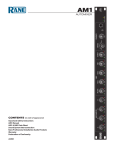Download Video title: Bike Helmets 101: A Basic User's Guide to Brain Safety
Transcript
Video title: Bike Helmets 101: A Basic User’s Guide to Brain Safety Skull, dome, melon, nut... No matter what you call your head I think we can all agree it’s worth protecting, right? When you’re doing something cool like riding a bike, you’ll find that hazards are everwhere; from car doors to gravel on the street, to dogs crossing your path. Yeah, even the cute ones. Crashes can happen – even to those with awesome biking skills. In a fight between your head and the pavement - the pavement always wins. So it makes sense to protect your skull and the valuable grey matter inside by wearing a certified helmet. Girl says “Yeah!” with dubbed deep mans voice Think you’ll look like a dork? No way! There are plenty of cool-looking helmets out there with tons of styles and colours to choose from. There’s downhill and bmx helmets, mountain bike helmets, road helmets, and racing helmets. Whatever style you choose, make sure it’s for the kind of riding you’re doing, and that its safety certified. Visit any good bike shop or sporting goods store if you aren’t sure what kind of helmet you need. They’ll have people to help make sure you’re making the right choice. 1 Even a certified helmet has to fit right to work properly. When picking your size, make sure it doesn’t wobble around or fall off when you nod yes or shake no - even when the straps are undone. Some helmets come with extra pads you can attach, or a nifty crank to help you get dialed in.(pause) See? Once you have found the right helmet that fits you, remember the 2V1 rule: With your helmet sitting level on your head you should have no more than “2” fingers between your eyebrows and the bottom of the helmet The side straps should form a “V” shape just below your ears Adjust the chin strap so only “1” finger fits under there, like so. When you open your mouth wide like this – the helmet should still feel comfortable. SFX: opera vocal Taking care of your new helmet is easy. Just keep it in a cool dry place, away from excessive heat or direct sunlight. That’s bad for the foamy stuff that protects your brain-box. Clean off any grossness with a mild cleaner like dish soap and warm water. A certified helmet will last 3 to 5 years, after that it’s time to get a new one. If you have a crash, or there are visible signs of damage your helmet is officially toast. There are no accidents, only crashes – but nobody has one on purpose. So protect your brains and wear a helmet when you ride. This important message is brought to you by Can-Bike Manitoba, the Manitoba Cycling Association, and the Manitoba government. Have fun. Ride safely. 2








